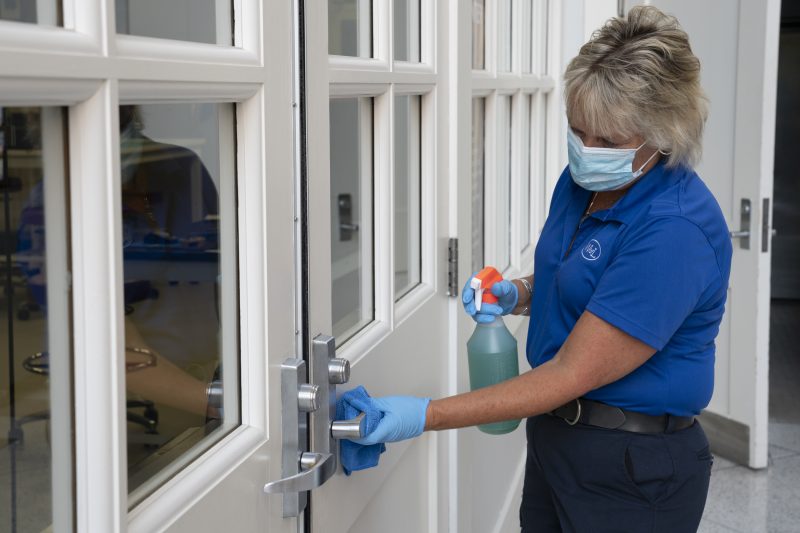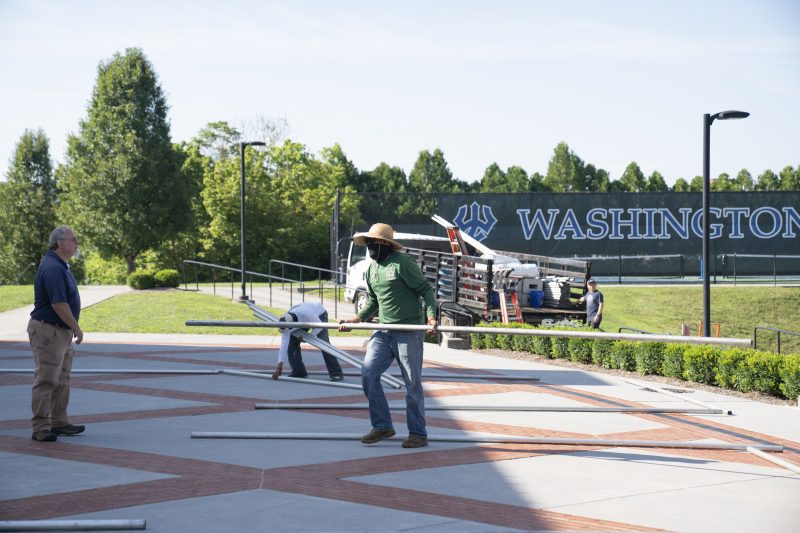Prepping for a Safe Return From installing hand sanitizer stations to adjusting HVAC systems, University Facilities staff have played an essential role in preparing the W&L campus for Fall Term 2020.
As Washington and Lee University prepares to welcome new and returning students for Fall Term, employees are putting the final touches on a multi-faceted, months-long endeavor to make campus facilities as safe as possible amid the ongoing COVID-19 pandemic.
The university’s COVID-19 safety plans have been led by a special committee that compiled data and shared information with the rest of the campus community, but University Facilities staff has carried out much of the hands-on work required to ensure that everyone has plenty of clean, disinfected and well-ventilated spaces in which to conduct business this term.
“Our team was the first one back on campus, so they’ve been here all summer working hard to prepare the buildings for the safe return of faculty and students,” said Tom Kalasky, executive director of University Facilities. “In true fashion, they have pulled together and worked hard, and we feel good about the progress we’ve made and the conditions of our facilities.”
The entire Facilities staff of more than 125 employees reported to work on June 10, just after Virginia Gov. Ralph Northam lifted the stay-at-home order. Because they are on the front lines every day, which means doing higher risk tasks like cleaning residence hall bathrooms and changing air filters, the first item of business was safety training. Kalasky and Paul Burns, W&L’s director of environmental health and safety, conducted training that included the proper use of personal protective equipment (PPE) such as masks and gloves.
Custodial crews were instructed on new cleaning technologies that they are now using routinely, including EPA-approved one-step disinfectants and electrostatic sprayers. They also have implemented enhanced cleaning protocols in accordance with the Center for Disease Control’s guidance. Those protocols include cleaning and disinfecting all high-touch surfaces, including desks, tables and podiums.
In order to ensure that W&L’s HVAC systems are optimized to provide a safe indoor environment, Facilities is adhering to guidelines issued by organizations that include the American Society of Heating, Refrigerating and Air-Conditioning Engineers (ASHRAE), the Occupational Safety and Health Administration, and the CDC. With help from sub-contractors this summer, employees cleaned and performed maintenance on more than 130 air-handling units on campus.
“Most of this is part of our preventative maintenance plan,” Kalasky said. “We would normally do this work over a longer schedule, but the pandemic made it a priority, so what we usually do over the course of a year we completed over a couple of months.”
The HVAC systems were also adjusted for increased ventilation rates and longer run times. High-efficiency air filtration, which has proven effective at removing airborne viral loads, was already in place at W&L, as was Ultraviolet Germicidal Irradiation (UVGI), which damages the structure of airborne infectious particles, rendering them inactive. Humidity levels between 40 and 60% will be maintained wherever possible, as those levels have been shown to reduce the transmission of some airborne infectious organisms.
In conjunction with the working group that studied learning spaces, Facilities de-densified classrooms by rearranging furniture to ensure 36 square feet of space around each person. They also erected two large outdoor canopies to serve as temporary outdoor classrooms (W&L already has a permanent outdoor classroom, which will also come in handy). In rooms where it wasn’t possible to de-densify, such as laboratories, they erected Plexiglass barriers. They also installed Plexiglass in locations where face-to-face service is necessary, such as the library circulation desks, reception counters and University Store sales counter.
In all, Plexiglass was installed in more than 80 different spaces around campus. University Facilities staff managed to save both time and money on the project by being forward-thinking and resourceful. According to Kalasky, Facilities ordered Plexiglass from local sources in April, not long after W&L went to virtual instruction, because they anticipated that the product would be in high demand. Instead of purchasing pre-made dividers, employees fabricated those with help from the carpentry shop and 3D printers in the IQ Center.
“This was all about being proactive and anticipating things,” Kalasky said. “We didn’t have a playbook for this. We were in uncharted waters, so I think it was just the good collective thoughts and experiences of the team that guided us.”
Other safety measures include the installation of 300 hand sanitizer dispensers across campus, the installation of signage to communicate health and safety messages, and the distribution of hand sanitizer and disinfectant wipes for faculty, staff and students to use in personal and work spaces.
Those efforts dovetailed nicely with those of Auxiliary Services employees, who have filled more than 2,750 orders for PPE kits to be used by faculty, staff and students. As part of that project, Auxiliary Services staff have processed orders for more than 31,000 disposable masks, more than 9,000 reusable fabric masks, more than 750 face shields, 29,620 fluid ounces of hand sanitizer, nearly 3,000 packages of sanitizing wipes and more than 2,000 thermometers.
Kalasky said his team will continue to use enhanced protocols to keep the W&L community safe through Fall Term, but they will also remain adaptable, a quality that has proven to be of the utmost importance during the pandemic.
“The key will be the ability to remain flexible and have multiple plans,” he said. “Anymore, it’s not good enough to just have a plan. You have to have plans A, B and C and be prepared to adjust — or do a complete pivot — based on changing conditions and guidance.”
 Senior Lead Residential Custodian Travis Black uses a new electrostatic sprayer to disinfect a classroom prior to the start of Fall Term.
Senior Lead Residential Custodian Travis Black uses a new electrostatic sprayer to disinfect a classroom prior to the start of Fall Term. Residential Custodian Kay Jones wipes down door handles with EPA-approved disinfectant.
Residential Custodian Kay Jones wipes down door handles with EPA-approved disinfectant. A rental installation crew sets up a canopy that will serve as outdoor classroom space for Fall Term 2020.
A rental installation crew sets up a canopy that will serve as outdoor classroom space for Fall Term 2020.
You must be logged in to post a comment.